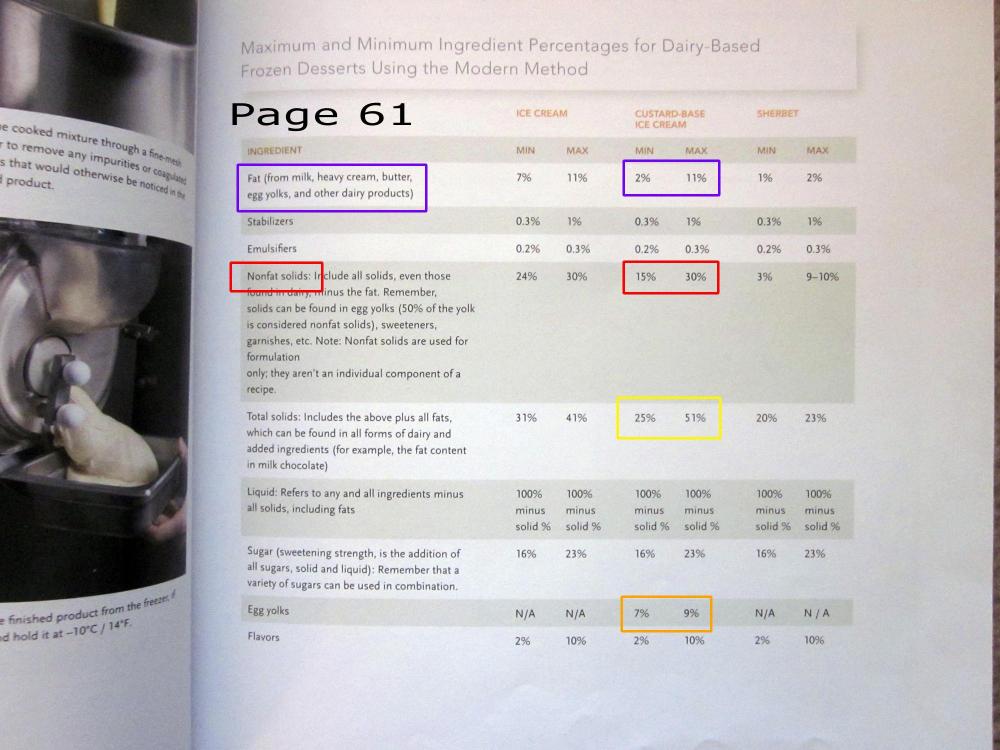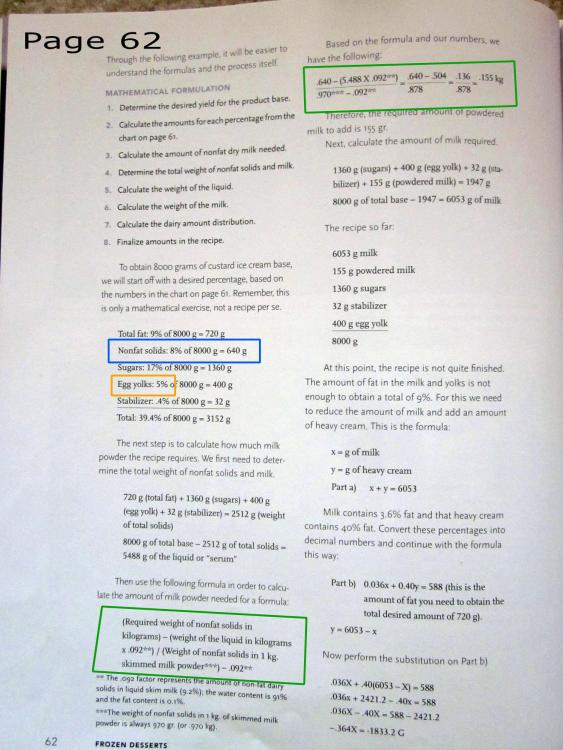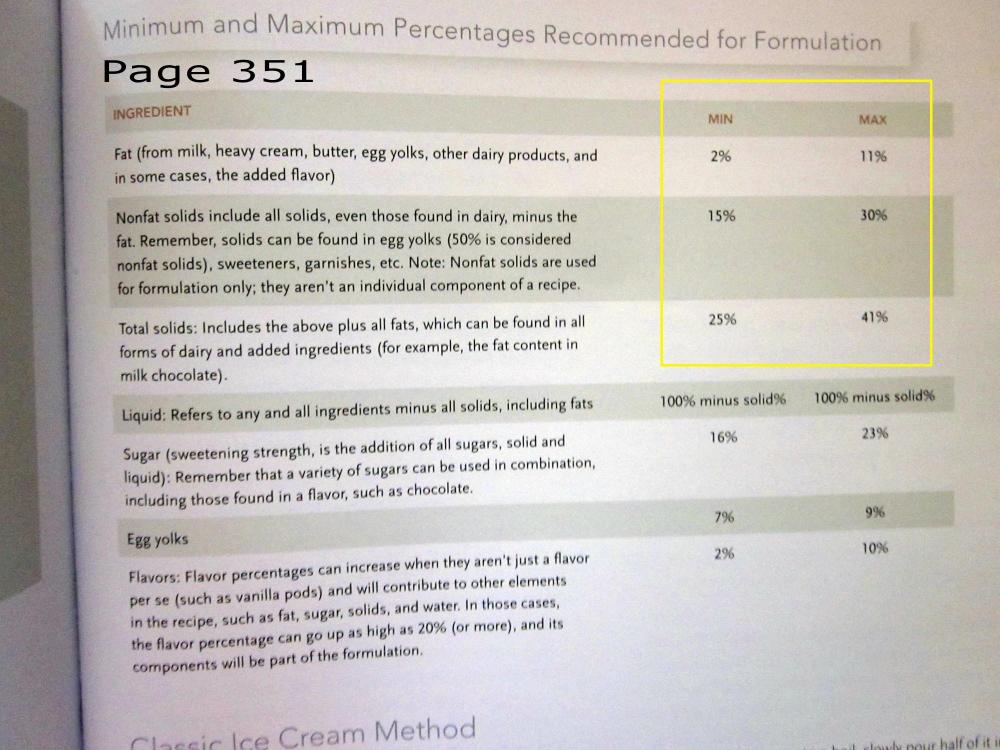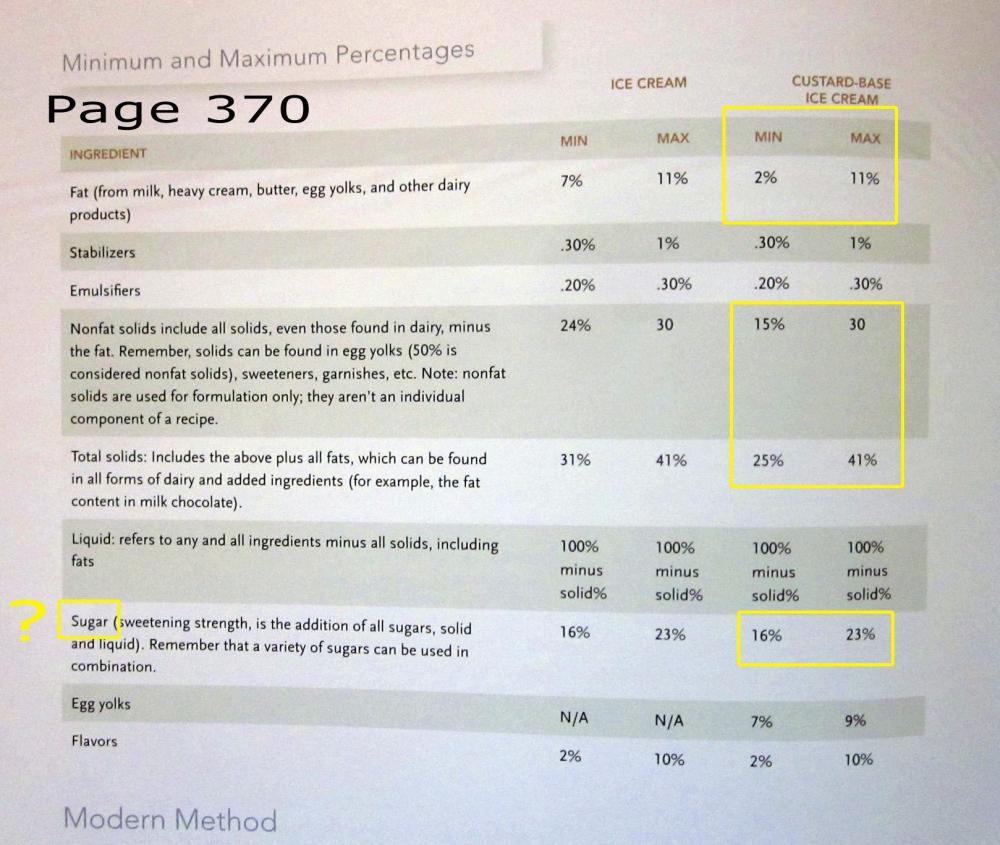
sweettreateater
participating member-
Posts
23 -
Joined
-
Last visited
Content Type
Profiles
Forums
Store
Help Articles
Everything posted by sweettreateater
-
I agree completely with that. For me, adding nonfat dry milk seems like the single biggest thing which improves my ice creams, even more than the heating... Also, very interesting what you said, paulraphael, about Jenni's commercial production solution... I was going to try what she does but my reverse osmosis machine is in the shop.
-
While we're at it, this is an awesome ice cream blog: https://underbelly-nyc.blogspot.com Amazing info there, along with some pretty witty writing. He also posts here with very insightful suggestions.
-
JoNorvelleWalker is a close second...
-
I have a feeling that the 4 minute instruction is a way to achieve some of the benefits of Ruben's method, while keeping things ultra simple. Not sure why it's 4 minutes vs 5, though... that might be the amount of time she found achieves the texture she likes. I definitely think that Ruben's method results in a super creamy ice cream. However, I have not found a way to separate the effect of evaporation from the effects of the protein denaturing. For instance, what percentage of the improvement is due to evaporation and how much due to denaturing? Is it 50/50, 70/30, or something else? Or do they work at different rates throughout the 25 minute period? For instance, does denaturing play a bigger part at first and then evaporation takes over towards the end? Or is it equal throughout? It could matter because if, for example, denaturing is the bigger player and it happens mostly at the beginning, the heating time could be reduced a lot, and still achieve most of the benefits. One equation and two variables... It's all also a bit subjective because some people (ie, my girlfriend) does not like how "chewy" it comes out, whereas that's exactly what I like about it. So I could heat it less and achieve less "chewiness" which would result in her being happy but me getting less ice cream. Funny how Ruben seems to now have a method named after him... He does sometimes post here so hopefully he will chime in. He's the expert on this!
-
Never tried that.... seems pretty hard-core and uncomfortable. I usually just go sit on the couch instead.
-
One thing I've done when including fruit like chopped cherries is to simmer them in a few tablespoons of sugar for about 10 minutes. I think that helps lower the freezing point of the water in the fruit chunks and keeps them chewy and un-frozen. Otherwise, they just become little chunks of ice. I freeze them the day before and then drop them in at the end of the spin. They should be chewy right out of the freezer.
-
Great - after I just made a chocolate ice cream batch yesterday... But good for next time!
-
Thanks for posting your sorbet formulations - super helpful! 18% sugar by weight seems fairly low - does that correspond to a Brix reading of 18 as well? Also, I've mostly made sorbets without using a simple syrup, to try to avoid diluting the fruit flavor intensity. Is there any advantage to using the simple syrup vs just dissolving the sugar right in the puree overnight? Now that I think of it, I'm guessing you would kind of need to do it if you are using stabilizers... Started the base for Bing cherry sorbet today - the Bings are really good this year. According to Migoya, cherries are 19% solids, so I was planning to not strain the puree to try take advantage of the "free solids". But as I was pureeing the last half, I heard the distinct sound of a pit being chewed up so I ended up having to strain about half the the puree to avoid getting bits of the stone in the final product. But hopefully there is still enough solids in there.
-
I made a watermelon sorbet and reduced some of the puree. Since I wasn't sure how the reduction would alter the flavor, I reduced only half the puree, and I reduced that part 20% by weight. So the entire amount of puree was reduced by 10%. After reduction, the smell was a little odd and non-fruit like, though the taste was different than the smell and was OK. It's hard to say if reducing affected the flavor but it didn't ruin it either. Overall, the finished product was quite good, taste-wise. The watermelon flavor came through pretty strong. It was a little on the too- sweet side, though. I felt that there were some defects too: it froze a little too cold and ended up too hard right out of the freezer, and the texture was a little crumbly. Once it warmed up, the texture was good and the crumbliness went away. Anyone have any ideas what would cause a crumbly texture in a sorbet? Since the sugar level was comparable to other sorbets I've had success with (particularly strawberry), my guess is the watermelon sorbet was lacking solids. I also used corn syrup as the invert. I opted not to strain it, hoping to retain some extra solids but maybe that is not enough. I am definitely thinking about trying either some nonfat milk solids, or get some stabilizers to try. I wanted to try it with as few extra ingredients as possible but I think a thin juice like watermelon might need a little help. I might get some dextrose as well, to add some FP suppression without adding sweetness. Here was the formulation I tried: (start) 30 oz fresh watermelon puree, unstrained (final) 27 oz watermelon, after reducing half of it by 20% 8.25 ounces sugar 4.70 ounces of corn syrup 1 tsp lemon juice 1/16 tsp pinch of salt Edit: I checked and my strawberry sorbet actually has more sugar in it (37% of total weight vs 30% of total weight). That could partly explain the difference in hardness.
-
I also think a sorbet would be better. It seems like the problem could be in ensuring sufficient solids. Besides sugar, what could you add to increase the solid percentage? With lemon sorbets, the flavor is so sour that you have to add a lot of sugar and I guess that takes care of the solids but that much sugar might overwhelm the watermelon... I usually strain when I make sorbets but maybe if I didn't, that might increase the solids enough without hopefully detracting too much from the final smoothness. I like the idea of reducing some of the watermelon juice.
-
Interesting Sugar post on underbelly. I have quite the sweet tooth so I never think ice cream is too sweet. I only know it's too sweet when it won't stay frozen in my -10 freezer! That's actually happening right now with a coffee ice cream I just made. Even I think it's too sweet. Just kidding. I've been using corn syrup for quite a while but have been curious to try a different kind of invert sugar. I found a smaller sized example (22 oz) of Trimoline for $7.25 at lepicerie. Would you say that the DIY formula for invert syrup on your site is equivalent to a commercial product like the one just mentioned? Is there any difference with the homemade one? Really enjoying the underbelly blog. You do a great job of summarizing and explaining concepts, especially the "trade-offs" with formulation changes. A lot of other blogs and books offer a lot more detail but with less clarity.
-
The information in underbelly is great! I particularly liked the 'Discussion' section in Basic Ice Cream Examples, where you showed how a change in the recipe can result in unexpected deficiencies, but then how to counter that effect by changing other parts of the formulation. It really demonstrates the crucial balancing act that ice cream-making is! And it really helps make clear what each part of the formulation does. One thing that I would personally really like to see is an entire posting on Solids: how to calculate them from your ingredient list, how to add them in when needed, how to counter them when they come in too high. I find the whole Solids component the trickiest part to understand well. It was covered in How To Build a Recipe but I wouldn't mind seeing more, especially how to manipulate the percentage. For instance, how would you get enough solids if you were making a watermelon ice cream? You need a ton of watermelon juice to get enough flavor (because it's a relatively non-intense juice next to say, lemon), but then how do you maintain a high enough solid percentage without diluting the flavor?
-
I've also had really good success with Ruben's method. This week, I tried a comparison test where I used the exact same proportions of ingredients but just dumped everything in the pot, brought it to 162, let it simmer for about 5 minutes, and then put in an ice bath. The result was OK but definitely did not have that unique creaminess. I wonder what are the biggest contributors? Is it the reversible protein unfolding and denaturing? Or is it mainly just due to evaporating so much water out of the base, which is ultimately what would contributing to any iciness? Also, I realized recently that I've been setting up all my percentages BEFORE reducing it. Then I realized that since the actual amount of base that gets churned is 13% lighter, (since I've removed about 13% of water from the base with evaporation), it also means that my ingredient percentages all increase quite a bit. I noticed today that Ruben mentions this on his site (ie, arrive at the proper mix composition AFTER heating) but I didn't see it before. The ice creams have been pretty soft at 5 degrees out of the freezer (though I kind of like that consistency), and now I think that's because I have a higher percentage of sugar in the base than my pre-reduction numbers indicated which suppresses the freezing point...
-
Looking forward to this one. I have frequent, animated, high-volume discussions about stabilizers with my girlfriend who refuses to eat ice cream that contains them. I like to point out that the unfortunately named guar gum is no less natural than her precious kale, yet she refuses to yield to my logic. So I just trick her. My ice cream has no labels on it.
-
I remember you also had a lot of success using Ruben's method. Are you using the PHMB to utilize same basic theory? (ie, 30-60 minutes at 162 degrees, etc) Since I also like to play with chocolate, I'm quite interested in this gizmo. However, I don't have the space for a KA mixer so I would likely get the standalone version. Since I wouldn't have the mixer itself, I guess I'd still be standing there stirring but at least I wouldn't have to worry about the temperature. Have you found that the temperature remains consistent, even if it differs from what reads on the display?
-
Full disclosure: Two Ben & Jerry's at one sitting: OK, not really done on a regular basis. Maybe once, and with some regret. One B&J at a time: easy, but once must sustain the semblance of self-control, especially if others are around. Once they leave, well..
-
For me, this is a single serving. Two Ben and Jerry's falls into the "solidly indulgent, though not quite excessive" category. I have yet to broach the excessive threshold.
-
I do want one. And the link also gave me some recipe ideas: "Complete homogenization of soft tissue (muscle, liver, brain, etc.) is usually achieved in one minute or less."
-
I liked the "Ice Cream Technique" post on the underbelly blog! This was an interesting idea: "Here’s a trick for if you’re using anything less powerful than a true homogenizer: Don’t add the cream to your recipe until after the cooking step. It’s the source of most of the milk fat, and if you don’t cook it, you won’t de-homogenize it." But it also made me wonder: doing it this way, would you also lose the benefit (for the cream portion) of the protein denaturing, since it would not be heated? Or would the trade-off for not losing the homogenization be worth it?
-
That's great! Looking forward to another great ice cream resource!
-
Thanks for the info! So his recommendation for nonfat solids between 15% and 30% seems awfully high. On the page 351 example above, he lists examples of what non-fat solids are, and he does include "sweeteners", maybe meaning sugar? So maybe that is how he gets to the 15%-30%? Though he does add sugar separately at the bottom. So maybe not... Just so I understand, "all nonfat solids" means everything non-liquid (except the sugar)? So basically, there are three elements: liquids (and the fat in the liquids), nonfat solids, and sugar? So if you have, let's say, 10 oz of 72% dark chocolate as an ingredient, which I think is about 42% fat, the chocolate would add 5.8 oz of nonfat solids? Or 10 oz of peaches at 85% water would add 1.5 ounces of nonfat solids? (not sure if the percentages are exactly right but just trying to get the concept...) I've kind of given up on the book as well - with all the errors, I'm never sure if what I am reading is correct. My favorite typo was where it actually said, "Please see chart on page XXX". I'll probably keep it because I am sure the theory behind what he's explaining is correct, even if the published numbers are sometimes baffling.
-
Thanks, yes, I did previously find that update when I was searching around for an errata page. Unfortunately, it doesn't address any of the typos. I was hoping I could find an email address for him to ask him directly!
-
Hi, I’ve learned a ton about ice cream making on this forum and wanted to start off by saying thanks to everyone for sharing their considerable expertise! I am hoping someone might be able to shed some light on a few questions… I recently purchased “Frozen Desserts” by Francisco Migoya, and while it seems to represent a wealth of information, I’m also a bit perplexed by some of the formulations. I’ve noticed quite a few typographical errors in the rest of the book, and when the math doesn’t work out, I am not sure if I just don’t get it or if it’s a mistake… I’ve uploaded images of a few of the pages where things are bit confusing. I’ve circled the issues in squares of various colors. Hopefully not too confusing. Here goes... 1. It states on page 61 that for a custard-based vanilla recipe, the nonfat solid percentage should be between 15% - 30% (red square). However, on the next page (page 62) on the example, it seems to indicate that there should only be 8% nonfat solids (blue square). Shouldn’t it be between 15% and 30%, as it states on the previous page? 2. Still on page 62, it calculates the amount of milk powder which needs to be added. There is a formula (green square). I understand the math, I just don’t quite understand the “why”. Besides the unknown origin of the 8% figure of .640 kg, I am not sure why the denominator is used. Wouldn’t you just need to subtract the fat solids from the formulation from the required weight of nonfat solids (all in the numerator), which would leave you with what is needed to add? Not sure why you divide by the .878 constant… 3. Also on page 62, it lists yolks at 5% of total (orange square), yet the range on page 61 recommends between 7 and 9% (also orange square). 4. Another oddity is on page 351 and repeated on page 370 (yellow squares). The total solids don’t seem to add up. For instance, in the Max column, adding the fat solids (11%) plus the nonfat solids (30%) equals 41%. However, in the Min column, adding those figures (2% + 15%) does not equal 25%. Oddly, back on page 61, what seems to be the same calculation appears to be incorrect at 51% (yellow square). Additionally, shouldn’t sugar be counted as a solid in the formulation? If so, that would bring both Min and Max totals well above what is on the chart… (also a yellow square) A couple of other general questions… What exactly is “serum”? From what I gather, it’s the “non-water” liquid(s) (ie, milk, cream), and would include both the solids and non-solids in that “non-water” liquid. Is this correct? On page 61, it says the total fat includes fat from milk, cream, etc, but also includes fat from yolks (purple square). Wouldn’t the relevant fat only be butterfat? It’s my understanding that the fat in yolks is not butterfat and doesn’t have the same effect on the final product as the fat from cream, etc… On the same line, it recommends a range of fat percentage between 2 and 11% for custard-based ice creams (also a purple square). I don’t think this is a typo because elsewhere in the book, it states that most of the recipes are formulated with low percentages of fat, about 6%. Does that seem a little low? OK, I will stop asking anymore questions, as I have run out of distinct colors to use. FWIW, I only tried one recipe from the book, the Vanilla, and was quite disappointed. It was grainy, icy, and tasted more like ice milk. You can just look at it and see it’s going to be pretty low in butterfat with so little cream… Here is the recipe from the book, scaled down in Excel: Whole milk: 31.56 oz Heavy cream: 5.58 oz Sugar: 7.50 oz Egg yolks: 3.35 oz (6 yolks) 1/8 teaspoon of salt 2 tsp of vanilla I really like the idea behind this book but I have not been able to figure out what is going on with some of those numbers! I have just received “Ice Cream” (Hoff and Hartel) and am looking forward to diving in. I've had great success with many of the ideas I've found on this forum, including the famous "Ruben Method"! I'm lucky: my lowest burner seems to be automatically set right at 162 degrees! Any thoughts would be much appreciated! Thanks!





